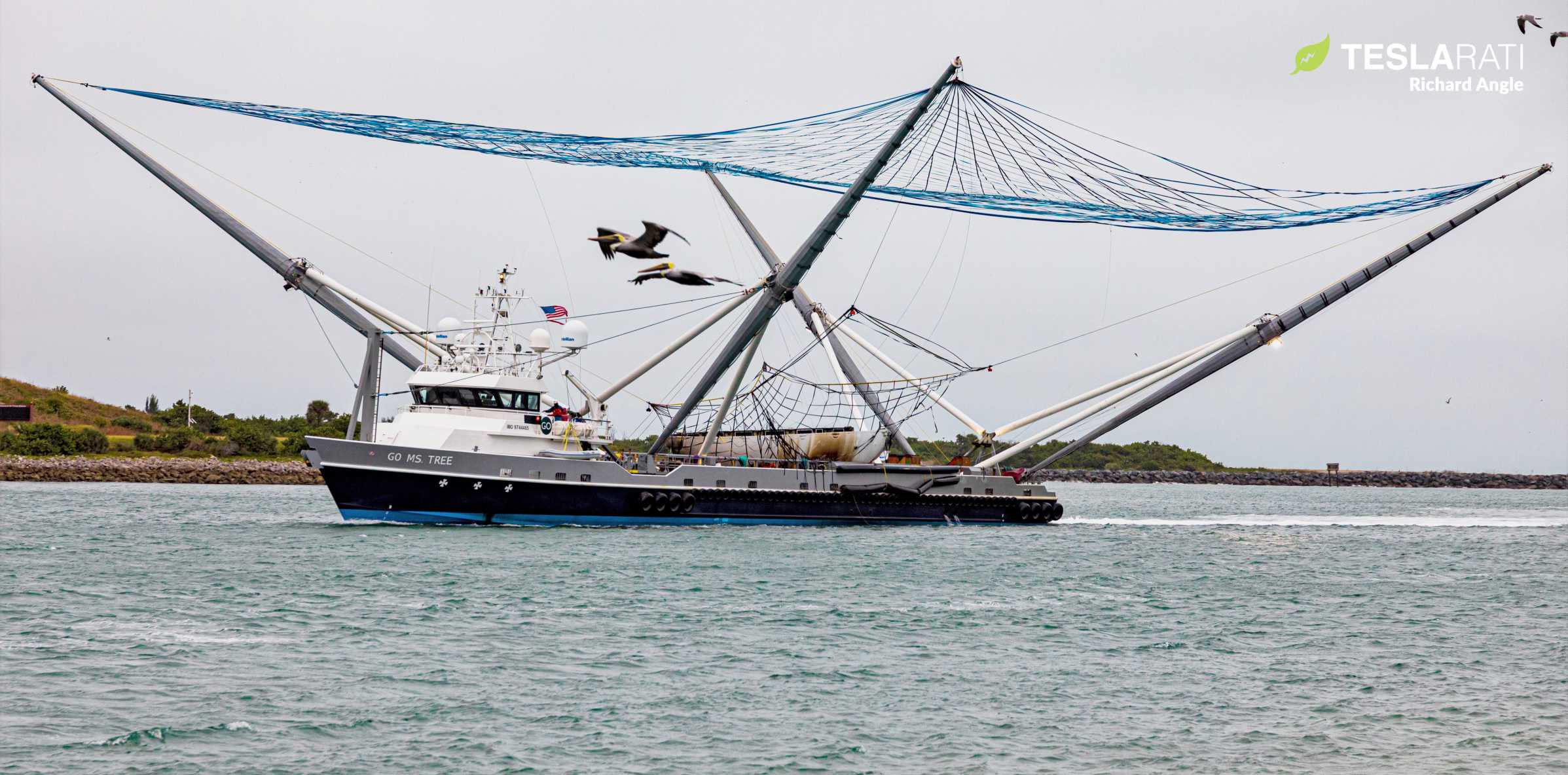
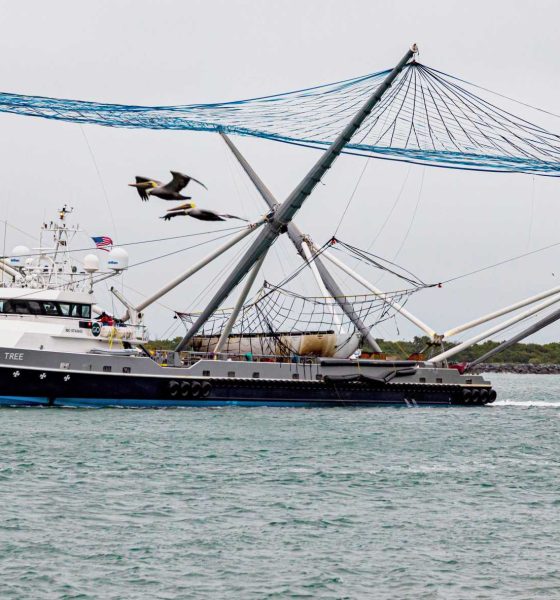
News
SpaceX fairing recovery ships return to port with Falcon 9 nosecone and battle scars
Four days after they headed out into the Atlantic Ocean, twin SpaceX fairing recovery ships Ms. Tree and Ms. Chief have returned to port with both halves of a Falcon 9 fairing, although they appear to have picked up some battle scars along the way.
Ms. Tree and its near-identical sibling Ms. Chief departed Port Canaveral on December 14th and arrived on station – 790 km (490 mi) off the coast of Florida – some 36 hours later. Each outfitted with a quartet of arms and pair of nets, it was the first time both ships successfully made it out into the Atlantic for a simultaneous fairing catch attempt, having been foiled by high seas during a prior November outing.
For unknown reasons, after the duo’s November false start, both ships stopped for almost two weeks at a South Carolina port, perhaps indicating that SpaceX was concerned about the structural integrity of the ships’ seemingly fragile net mechanism. In February 2019, Mr. Steven (now Ms. Tree) lost two of its four arms while heading downrange for an attempted catch, apparently broken off by pitching caused by high seas. Further strengthening the case that their net mechanisms are rather fragile, both Ms. Tree and Ms. Chief again suffered damage after their Kacific-1/JCSAT-18 Falcon 9 fairing recovery attempt.
Both ships arrived back at Port Canaveral on December 18th and were caught by Teslarati photographer Richard Angle while passing through the narrow mouth of the port. GO Ms. Chief took the lead, revealing a Falcon 9 fairing half snugly secured with a tarp on her deck – the ship’s very first launch vehicle hardware recovery.
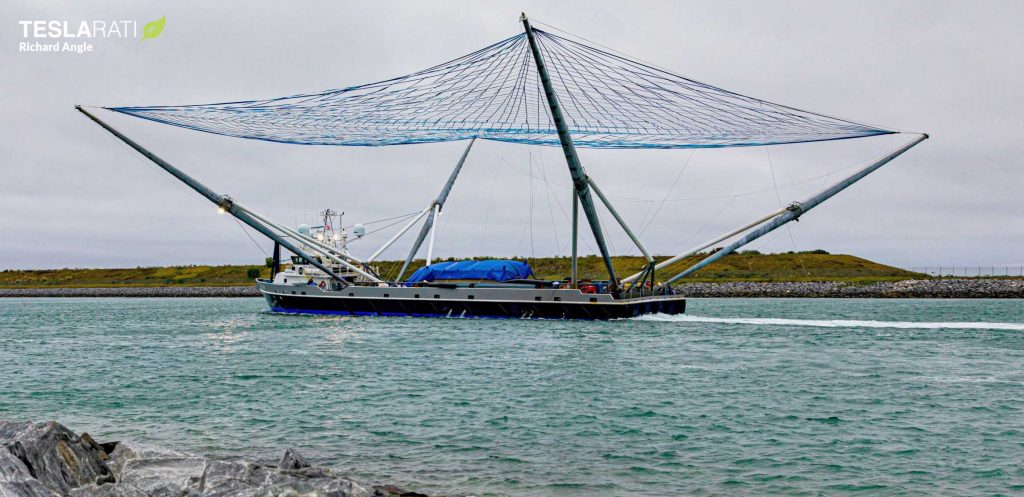
First (partially) successful fairing recovery quite literally under wraps, Ms. Chief nevertheless did not make it through the rite of passage unscathed. Oddly, it appears that just one of the ship’s eight white arm supports is missing (the rear right or aft starboard arm), visibly resulting in the arm slouching a bit compared to its siblings. Intriguingly, it appears that the arm is partially stretching – and thus potentially resting on – Ms. Chief’s net and rigging.
The fact that only one of the arm’s two beams (of eight total) seems to have failed is more immediately indicative of possible human error during installation or a defective attachment mechanism, although it’s entirely possible that a fluke of weather could have damaged just the one beam.
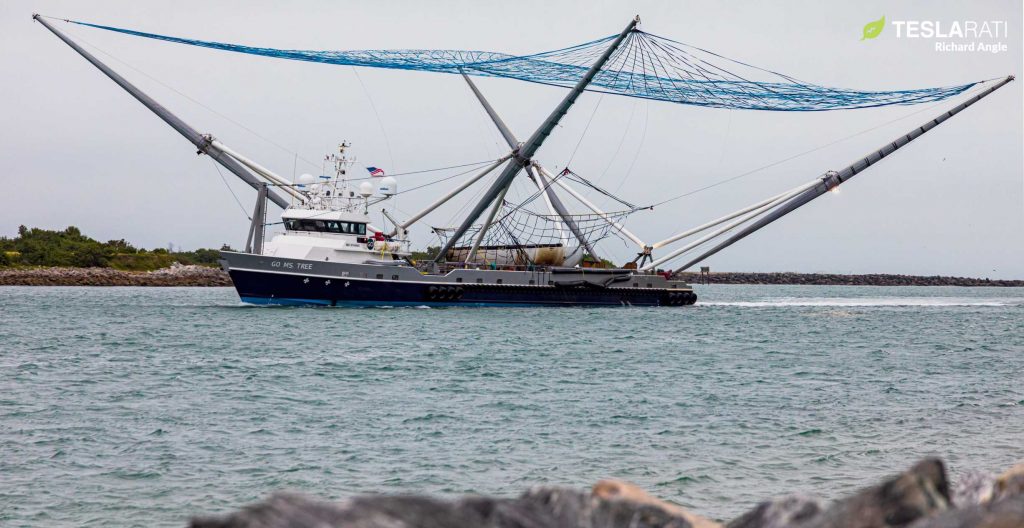
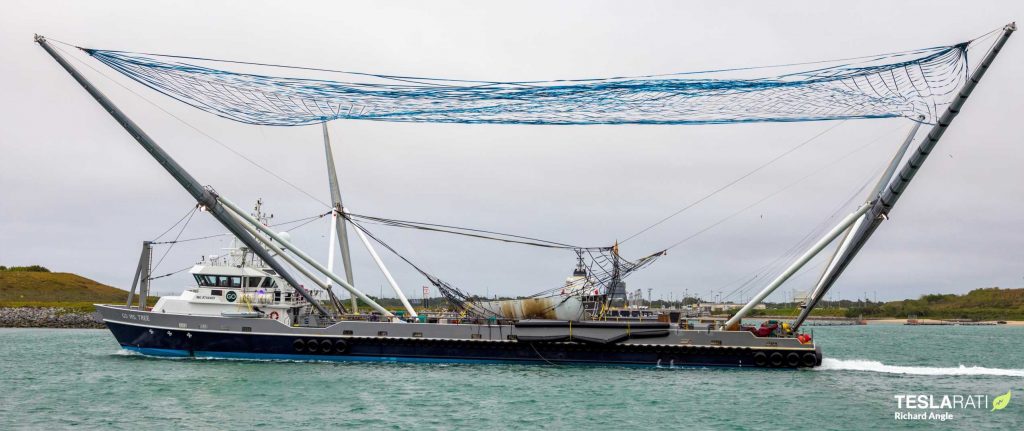
Thankfully, Ms. Tree (formerly Mr. Steven) appears to have made it through the recovery mission with all four arms fully intact, although the ship clearly struggled with a separate mechanism. Notably, Ms. Tree seems to have struggled to use its secondary net to lift its fairing half out of the sea and onto her deck, with that smaller net clearly suffering a multitude of rips and tears at some point during the process. Her recovered fairing half is somewhat awkwardly strewn on the deck with no obvious attempt to rectify the issue, indicating that the net may have torn mid-lift, causing the fairing to fall maybe 5-10 feet.
If it did actually fall onto Ms. Tree’s deck, that will almost certainly be visible in the form of damage to its aluminum-composite honeycomb structure and white insulation coating.
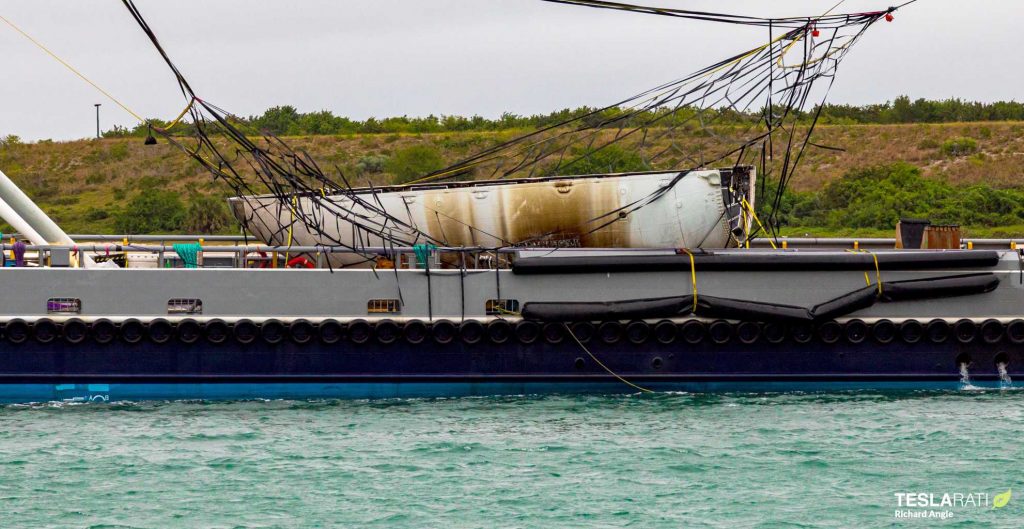
Ultimately, fairing recovery continues to prove itself to be a major challenge, although SpaceX obviously has no intention of giving up. With two successful catches already in hand, it’s clear that fairing recovery is undeniably possible and is more a matter of tweaking existing systems than starting from scratch. Much like Falcon 9 booster recovery had and its fair share of failed landings even after the first success, it will likely take quite a while for SpaceX to optimize fairing recovery to the point that it can be considered reliable.
For now, routine fairing recovery and reuse will likely continue to be Falcon 9’s white whale, at worst adding to the excitement of every SpaceX satellite launch.
Check out Teslarati’s Marketplace! We offer Tesla accessories, including for the Tesla Cybertruck and Tesla Model 3.

News
Tesla FSD fleet is nearing 7 billion total miles, including 2.5 billion city miles
As can be seen on Tesla’s official FSD webpage, vehicles equipped with the system have now navigated over 6.99 billion miles.

Tesla’s Full Self-Driving (Supervised) fleet is closing in on almost 7 billion total miles driven, as per data posted by the company on its official FSD webpage.
These figures hint at the massive scale of data fueling Tesla’s rapid FSD improvements, which have been quite notable as of late.
FSD mileage milestones
As can be seen on Tesla’s official FSD webpage, vehicles equipped with the system have now navigated over 6.99 billion miles. Tesla owner and avid FSD tester Whole Mars Catalog also shared a screenshot indicating that from the nearly 7 billion miles traveled by the FSD fleet, more than 2.5 billion miles were driven inside cities.
City miles are particularly valuable for complex urban scenarios like unprotected turns, pedestrian interactions, and traffic lights. This is also the difference-maker for FSD, as only complex solutions, such as Waymo’s self-driving taxis, operate similarly on inner-city streets. And even then, incidents such as the San Francisco blackouts have proven challenging for sensor-rich vehicles like Waymos.
Tesla’s data edge
Tesla has a number of advantages in the autonomous vehicle sector, one of which is the size of its fleet and the number of vehicles training FSD on real-world roads. Tesla’s nearly 7 billion FSD miles then allow the company to roll out updates that make its vehicles behave like they are being driven by experienced drivers, even if they are operating on their own.
So notable are Tesla’s improvements to FSD that NVIDIA Director of Robotics Jim Fan, after experiencing FSD v14, noted that the system is the first AI that passes what he described as a “Physical Turing Test.”
“Despite knowing exactly how robot learning works, I still find it magical watching the steering wheel turn by itself. First it feels surreal, next it becomes routine. Then, like the smartphone, taking it away actively hurts. This is how humanity gets rewired and glued to god-like technologies,” Fan wrote in a post on X.
News
Tesla starts showing how FSD will change lives in Europe
Local officials tested the system on narrow country roads and were impressed by FSD’s smooth, human-like driving, with some calling the service a game-changer for everyday life in areas that are far from urban centers.

Tesla has launched Europe’s first public shuttle service using Full Self-Driving (Supervised) in the rural Eifelkreis Bitburg-Prüm region of Germany, demonstrating how the technology can restore independence and mobility for people who struggle with limited transport options.
Local officials tested the system on narrow country roads and were impressed by FSD’s smooth, human-like driving, with some calling the service a game-changer for everyday life in areas that are far from urban centers.
Officials see real impact on rural residents
Arzfeld Mayor Johannes Kuhl and District Administrator Andreas Kruppert personally tested the Tesla shuttle service. This allowed them to see just how well FSD navigated winding lanes and rural roads confidently. Kruppert said, “Autonomous driving sounds like science fiction to many, but we simply see here that it works totally well in rural regions too.” Kuhl, for his part, also noted that FSD “feels like a very experienced driver.”
The pilot complements the area’s “Citizen Bus” program, which provides on-demand rides for elderly residents who can no longer drive themselves. Tesla Europe shared a video of a demonstration of the service, highlighting how FSD gives people their freedom back, even in places where public transport is not as prevalent.
What the Ministry for Economic Affairs and Transport says
Rhineland-Palatinate’s Minister Daniela Schmitt supported the project, praising the collaboration that made this “first of its kind in Europe” possible. As per the ministry, the rural rollout for the service shows FSD’s potential beyond major cities, and it delivers tangible benefits like grocery runs, doctor visits, and social connections for isolated residents.
“Reliable and flexible mobility is especially vital in rural areas. With the launch of a shuttle service using self-driving vehicles (FSD supervised) by Tesla in the Eifelkreis Bitburg-Prüm, an innovative pilot project is now getting underway that complements local community bus services. It is the first project of its kind in Europe.
“The result is a real gain for rural mobility: greater accessibility, more flexibility and tangible benefits for everyday life. A strong signal for innovation, cooperation and future-oriented mobility beyond urban centers,” the ministry wrote in a LinkedIn post.
News
Tesla China quietly posts Robotaxi-related job listing
Tesla China is currently seeking a Low Voltage Electrical Engineer to work on circuit board design for the company’s autonomous vehicles.

Tesla has posted a new job listing in Shanghai explicitly tied to its Robotaxi program, fueling speculation that the company is preparing to launch its dedicated autonomous ride-hailing service in China.
As noted in the listing, Tesla China is currently seeking a Low Voltage Electrical Engineer to work on circuit board design for the company’s autonomous vehicles.
Robotaxi-specific role
The listing, which was shared on social media platform X by industry watcher @tslaming, suggested that Tesla China is looking to fill the role urgently. The job listing itself specifically mentions that the person hired for the role will be working on the Low Voltage Hardware team, which would design the circuit boards that would serve as the nervous system of the Robotaxi.
Key tasks for the role, as indicated in the job listing, include collaboration with PCB layout, firmware, mechanical, program management, and validation teams, among other responsibilities. The role is based in Shanghai.
China Robotaxi launch
China represents a massive potential market for robotaxis, with its dense urban centers and supportive policies in select cities. Tesla has limited permission to roll out FSD in the country, though despite this, its vehicles have been hailed as among the best in the market when it comes to autonomous features. So far, at least, it appears that China supports Tesla’s FSD and Robotaxi rollout.
This was hinted at in November, when Tesla brought the Cybercab to the 8th China International Import Expo (CIIE) in Shanghai, marking the first time that the autonomous two-seater was brought to the Asia-Pacific region. The vehicle, despite not having a release date in China, received a significant amount of interest among the event’s attendees.








